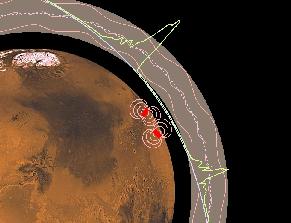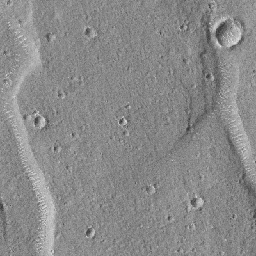An image released on 09/07/98 showing the mysterious "Giant Polygons" of the Martian northern plains. These "Polygons" were first seen by the Viking Orbiters in the 1970's...they appear to be huge cracks in the surface of the Red Planet.
Click on image for full size
Courtesy of NASA
Exploring Mars - Slowly But Surely...
News story originally written on September 11, 1998
The
Mars Global Surveyor (MGS) reached the Red Planet in September 1997. It has circled the planet nearly 600 times so far. Unfortunately, problems with one of the high-gain antennae is slowing exploration down.
The Surveyor spacecraft will complete its aero-braking procedures, bringing the Surveyor into its final and closer orbit to the Red Planet. From this lower orbit, detailed mapping of the surface can occur. After the aerobraking is finished, the high-gain antenna could be opened allowing for speedy transfer of the mapping data. However, managers are not sure that the high-gain antenna will open correctly. In the worst-case scenario, contact could be lost with the Surveyor spacecraft. So it is likely that a conservative decision to delay antenna deployment will be made in February 1999, a month before the main mapping portion of the mission is to start. This decision will maximize the probability of overall mission success.
Now that's not to say that the Surveyor is sailing through its Martian orbit with nothing to do. The Surveyor continues to do just that - survey! It recently was exploring features called the "Giant Polygons" (in the image to the left). Without the high-gain antenna, data can still be transmitted to the Earth, but it certainly takes a longer process.
You might also be interested in:

These are some of the initial findings of Mars Global Surveyor. The definite confirmation of the presence of a magnetic field near Mars. suggests scientists must rethink theories about the evolution of
...more
It was another exciting and frustrating year for the space science program. It seemed that every step forward led to one backwards. Either way, NASA led the way to a great century of discovery. Unfortunately,
...more
The Space Shuttle Discovery lifted off from Kennedy Space Center at 2:19 p.m. EST, October 29th. The sky was clear and the weather was great as Discovery took 8 1/2 minutes to reach orbit for the Unitied
...more
A moon was discovered orbiting the asteroid, Eugenia. This is only the second time in history that a satellite has been seen circling an asteroid. A special mirror allowed scientists to find the moon
...more
Will Russia ever put the service module for the International Space Station in space? NASA officials are demanding an answer from the Russian government. The necessary service module is currently waiting
...more
During a period of about two days in early May, 1998, the ACE spacecraft was immersed in plasma associated with a coronal mass ejection (CME). The SWICS instrument on ACE, which determines unambiguously
...more
J.S. Maini of the Canadian Forest Service has referred to forests as the "heart and lungs of the world." Forests reduce soil erosion, maintain water quality, contribute to atmospheric humidity and cloud
...more















